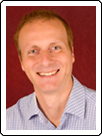3 quick steps to enlist your client's subconscious mind to help them heal
Why it's sometimes good to go beyond a treatment plan
By Mark Tyrrell
"Every person has abilities not known to the self."
Milton H Erickson
Sometimes, just sometimes, I don't know how my clients get better and they don't know either. But they definitely got better.
It's great to have a strategy with your clients and to have clear steps to help them heal,whether emotionally or physically. But it's a mark of a confident therapist, on occasion, to be able to;
- relinquish 'expertise' and entertain the idea that they have within themselves the capacity for healing, even though they may not know this
- ask their unconscious (sometimes known as the 'subconscious') mind to "do what it needs to do" in order to help them get better.
So what do I mean by your client's 'unconscious mind'?
The wisdom of the mind
You and I and everyone else are not consciously aware of most of what we are perceiving at any moment. For example, there is a part of your mind which is constantly monitoring
- your blood sugar levels
- your digestive processes
- fluctuations in your immune response
- tissue damage and healing in your body
- your emotional reactions to all kinds of triggers.
Most of this - perhaps all of it - is, and remains, outside of conscious awareness. And that's just fine. We don't have to try to "make everything conscious" in order to help people.
However, we can influence the unconscious in all kinds of ways. For example, when a patient responds to a placebo treatment, her unconscious mind has been influenced - and the mechanism of that influence is below conscious awareness.
It's as if taking the placebo pill, or going through the placebo procedure, has in effect 'said' to the unconscious mind: "You are the expert. Do whatever you do to make this healing happen."
So how can we ask the unconscious mind to "do its stuff"?
1. Acknowledge the riches of the wisdom store
During hypnosis, draw attention to the differences between conscious and unconscious processes and acknowledge how much the unconscious mind is capable of.
For example:
You have a conscious mind, really quite a small part of your mind, which analyses, justifies, uses logic and sequential thinking... and you have an amazing and rich reservoir of unconscious processes, all with incredible potential to heal... and it's that part, the non- conscious part of you, that I'm going to be talking to...
2. Speak directly to the unconscious
Next - just ask the unconscious mind to get to work.
For example:
And that part of you that knows more about you than you do can really begin, over the coming hours, days, weeks and months, to make all the changes necessary to help you heal... and all your conscious mind needs to do... is start to enjoy noticing that happening...
3. Get confirmation
After you've made a direct approach to the unconscious mind, you can ask for an unconscious response to confirm that their unconscious mind has understood and 'agreed' to do what it needs to do.
For example:
So right now I'm asking your unconscious mind to do what it needs to do... in order to heal up that skin... [or whatever healing is sought] and perhaps your unconscious mind can let you and me know... when this has already started to happen... maybe just an unconscious twitch of a finger on the right or left hand... or maybe one hand will become lighter than the other and start to float up... all by itself... or maybe your head will gently nod even though you don't consciously know it...
It's incredible to receive a 'signal' from a person's unconscious mind in this way. It reminds us where the real power lies.
It's good to work consciously and to put all our effort and expertise into helping our clients in the most effective way possible. But sometimes we really can do better by appealing to a person's own 'wisdom store' to make appropriate changes.
And neither you nor they need know exactly how those wonderful changes happen.

Help depressed clients quickly: Free eBook
Get '5 Things You Must Do When Treating Depressed Clients' free when you subscribe for email updates.

You can learn How to Stop Anyone Smoking with Mark Tyrrell on our Smoking Cessation Training Course (online).
Back to Therapy Techniques articles
blog comments powered by Disqus




 PDF
PDF Email
Email Print
Print

